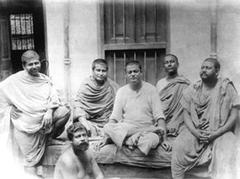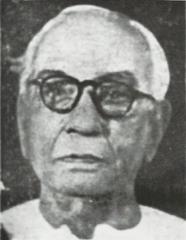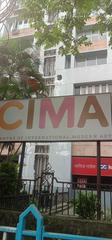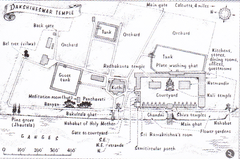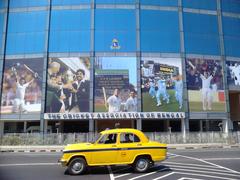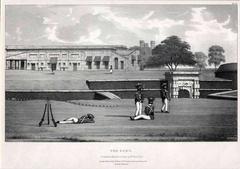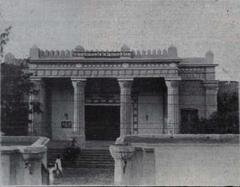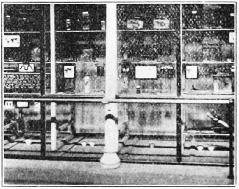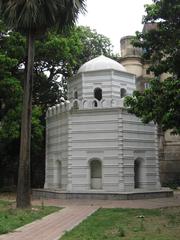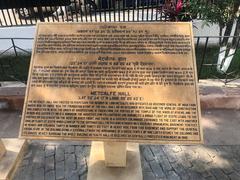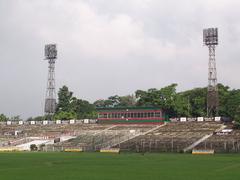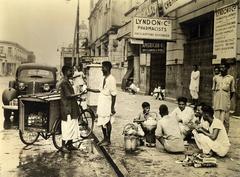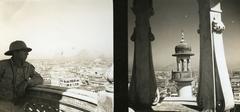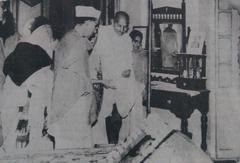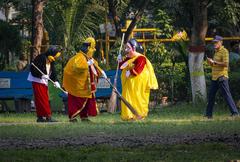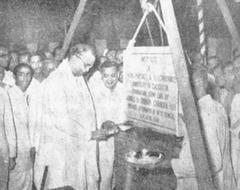Rabindra Bharati University Kolkata: Visiting Hours, Tickets, and Travel Guide
Date: 14/06/2025
Introduction: Historical Significance and Visitor Information
Rabindra Bharati University (RBU), founded on May 8, 1962, in Kolkata, India, stands as a renowned institution dedicated to perpetuating the legacy of Rabindranath Tagore—Asia’s first Nobel Laureate in Literature. Established under the Rabindra Bharati Act by the West Bengal Legislature and inaugurated by Prime Minister Jawaharlal Nehru, the university was envisioned as a “temple of learning” to nurture the literary, artistic, and philosophical ideals of Tagore (rbu.ac.in, kolkatatourism.travel).
The historic Jorasanko Thakur Bari, Tagore’s ancestral home and the university’s nucleus, functions as both a cultural landmark and a museum. It houses over 700 exhibits, including manuscripts, paintings, and personal artifacts, offering visitors a unique glimpse into the Tagore family’s role in the Bengal Renaissance (kolkatatourism.in, Krishi Jagran).
RBU’s academic structure focuses on the humanities, fine arts, and social sciences, reflecting Tagore’s vision of holistic education. The university operates primarily from two sites: the Emerald Bower Campus (academics and administration) and the Jorasanko Campus (museum and major cultural events) (media.rbucdoe.ac.in, rbu.ac.in).
Visitors can immerse themselves in vibrant festivals such as Basanta Utsav and Tagore Jayanti, attend exhibitions and performances, and explore neighboring heritage sites like the Indian Museum and College Street. The university is easily accessible by Kolkata Metro and other public transport, making it a welcoming destination for international scholars, art lovers, and culture enthusiasts (kolkatatourism.travel, theunstumbled.com).
This guide delivers essential details on visiting hours, tickets, accessibility, events, and travel tips, ensuring a rewarding experience at Rabindra Bharati University (rbu.ac.in, kolkatatourism.in).
University Origins and the Jorasanko Thakur Bari
Founding of Rabindra Bharati University
RBU was established in 1962 to mark the centenary of Rabindranath Tagore’s birth and to preserve his intellectual and cultural heritage (rbu.ac.in). The university’s main site, Jorasanko Thakur Bari, was chosen for its deep connection to the Tagore family and the Bengal Renaissance (kolkatatourism.travel). The initiative, led by Dr. Bidhan Chandra Roy, was a landmark in India’s educational and cultural landscape (media.rbucdoe.ac.in).
Historical Significance of Jorasanko Thakur Bari
Jorasanko Thakur Bari, the Tagore family’s ancestral home, is a crucial site in Bengal’s cultural awakening. It was the birthplace and creative hub for Rabindranath Tagore, as well as other luminaries like Gaganendranath and Abanindranath Tagore. The mansion served as a focal point for the Brahmo Samaj movement and the Bengal Renaissance, making it a pilgrimage for those interested in Indian art and literature (kolkatatourism.in).
The transformation of the mansion into the Rabindra Bharati Museum and the university campus underscores the commitment to preserving and celebrating the Tagore family’s contributions (kolkatatourism.travel).
Academic Evolution and Cultural Impact
Growth and Academic Offerings
Originally focused on music, dance, and drama, RBU has evolved to offer a broad spectrum of courses in humanities, social sciences, fine arts, and cultural studies (admissionsdunia.in). The main faculties—Arts, Fine Arts, and Visual Arts—are based at the Emerald Bower Campus, while the Jorasanko campus hosts major cultural events (rbu.ac.in).
The university has introduced contemporary disciplines such as Geography, Human Rights, Sociology, Environmental Studies, and Mathematics, maintaining a balance between tradition and modernity (media.rbucdoe.ac.in).
Accreditation and Recognition
RBU is recognized by the University Grants Commission (UGC) and accredited by the National Assessment and Accreditation Council (NAAC), holding Grade A accreditation and a CGPA of 3.10 (media.rbucdoe.ac.in). Its distance and online education programs are approved by the Distance Education Bureau (DEB).
Mission and Philosophy
Rabindra Bharati University’s mission is the dissemination of Tagore’s ideals through education in the humanities, social sciences, and arts (rbu.ac.in). Emphasizing creativity, critical thinking, and inclusivity, RBU admits a significant number of first-generation and rural students and supports them through remedial programs. International students are also welcomed, often through the Indian Council for Cultural Relations (ICCR).
Cultural and Academic Contributions
The university has nurtured many renowned artists, writers, and performers, such as Sisir Bhaduri, Shambu Mitra, Suchitra Mitra, and Shanu Lahiri (rbu.ac.in). RBU is also known for its vibrant cultural calendar, featuring festivals like Basanta Utsav and Tagore Jayanti (theunstumbled.com).
Facilities and Campuses
- Emerald Bower Campus: 56A, B.T. Road, Kolkata—home to academic departments and administration (rbu.ac.in).
- Jorasanko Campus: 6/4, Dwarkanath Tagore Lane, Kolkata—includes the Rabindra Bharati Museum and cultural venues (kolkatatourism.travel).
The university’s Centre for Distance and Online Education (CDOE) offers flexible learning opportunities (media.rbucdoe.ac.in).
Visitor Information: Jorasanko Thakur Bari and Rabindra Bharati University
Visiting Hours and Tickets
- Museum Hours: 10:30 AM – 5:30 PM (Closed Mondays and public holidays).
- Entry Fee: INR 20 for Indian nationals, INR 200 for foreigners; tickets at the entrance.
- Light and Sound Show: Two shows daily (except Mondays), with separate ticketing.
Accessibility
- Ramps and accessible restrooms are provided; some heritage areas may be less accessible. Contact ahead for assistance.
How to Reach
- By Metro: Nearest stations—Shobhabazar Sutanuti, Girish Park, Mahatma Gandhi Road.
- By Road: Well-connected by bus, taxi, and auto-rickshaw. Parking is limited.
- By Rail: Barabazaar and Sealdah stations are nearby.
- By Air: 12 km from Netaji Subhas Chandra Bose International Airport.
Best Time to Visit
- October to March, when the weather is pleasant and major cultural events, such as Tagore Jayanti, are celebrated.
Guided Tours and Photography
- Guided tours are available in English and Bengali; request at the museum entrance.
- Photography is permitted in outdoor areas for a fee; prohibited inside galleries.
Nearby Attractions
- College Street: Iconic for books and cafes.
- Indian Museum: The oldest and largest in Asia.
- Marble Palace: Noted for art and architecture.
- Kumartuli: Traditional potters’ quarter (Wanderlog).
Visitor Tips
- Remove footwear in designated areas.
- Respect heritage and artifacts.
- Wear modest attire during festivals.
- Arrive early to avoid crowds, especially during events.
Digital and Virtual Experiences
- Virtual tours and online cultural events are available, especially during Tagore Jayanti (Krishi Jagran).
Academic and Cultural Engagements
Signature Festivals
- Basanta Utsav: Spring festival with music, dance, and colors (The Holiday Story).
- Poush Mela: Winter festival celebrating folk traditions.
- Tagore Jayanti: Grand commemorative events with performances and seminars (Touryatras).
Workshops and Outreach
- Regular music, theatre, and art workshops.
- Community outreach through the NSS.
- Distance education and career guidance (CollegeBatch, NTA Exam).
Facilities
- Well-stocked library, hostels, auditoriums, and performance spaces.
Frequently Asked Questions (FAQs)
Q1: What are the museum’s visiting hours?
A1: 10:30 AM – 5:30 PM, closed Mondays and public holidays.
Q2: How do I buy tickets?
A2: At the museum entrance; no online booking currently.
Q3: Is the site accessible for differently-abled visitors?
A3: Ramps and accessible restrooms are available; some heritage sections may be less accessible.
Q4: Are guided tours available?
A4: Yes, upon request; inquire at the entrance.
Q5: Can I take photographs?
A5: Allowed in outdoor areas for a fee; not inside galleries.
Q6: Which are the nearest metro stations?
A6: Shobhabazar Sutanuti, Girish Park, Mahatma Gandhi Road.
Q7: What nearby attractions can I combine with my visit?
A7: College Street, Indian Museum, Marble Palace, Kumartuli.
Planning Your Visit
- Visit the official website for schedules and updates.
- Download the Audiala app for audio guides and virtual tours.
- Check social media and tourism portals for event announcements.
Summary and Recommendations
Rabindra Bharati University is a beacon of Bengal’s cultural and literary heritage, offering visitors more than just academic excellence. From the historic Jorasanko Thakur Bari to the vibrant Emerald Bower Campus, RBU invites you to explore Tagore’s enduring legacy through immersive museums, signature festivals, and inclusive educational experiences (rbu.ac.in, kolkatatourism.travel).
Plan your visit for the cooler months or during cultural festivals for the richest experience, and explore nearby attractions to complete your journey through Kolkata’s storied past. Engage with guided tours, attend cultural programs, and utilize digital resources for a deeper understanding of RBU’s significance. The university’s commitment to accessibility and community engagement ensures a memorable and meaningful visit for all (theunstumbled.com, Medium).
References
- Rabindra Bharati University Official Website
- Jorasanko Thakur Bari, House of the Thakurs, Kolkata Tourism
- Jorasanko Thakur Bari, Kolkata Tourism
- Rabindra Bharati University Admission and Academic Details
- RBU Centre for Distance and Online Education Prospectus
- Krishi Jagran: Tagore Jayanti 2025
- Medium: RBU Centre of Cultural and Academic Excellence
- Basanta Utsav at RBU, The Unstumbled
- The Holiday Story
- Touryatras
- Wanderlog: Top Things to Do in Kolkata
- CollegeBatch
- NTA Exam: RBU Admission 2025
